new posts in all blogs
Viewing: Blog Posts Tagged with: Back to School, Most Recent at Top [Help]
Results 51 - 75 of 191
How to use this Page
You are viewing the most recent posts tagged with the words: Back to School in the JacketFlap blog reader. What is a tag? Think of a tag as a keyword or category label. Tags can both help you find posts on JacketFlap.com as well as provide an easy way for you to "remember" and classify posts for later recall. Try adding a tag yourself by clicking "Add a tag" below a post's header. Scroll down through the list of Recent Posts in the left column and click on a post title that sounds interesting. You can view all posts from a specific blog by clicking the Blog name in the right column, or you can click a 'More Posts from this Blog' link in any individual post.
Many library’s are in a great position to help teens develop skills and experience they can add to their resume. Whether it be volunteering on a regular basis or honing graphic design or other useful technology proficiency, teens can gain that needed edge through the library for when they seek out other opportunities.
Last school year, I stumbled across a program at my local public school system that gives students school credit for being part of a library program such as volunteering! What a win-win situation for all! Read on for more details on how the program works.
The Academic Internship program is for high schoolers (though targeting 16-18 year olds) to receive work-based learning opportunities and earn school credit. Library programs that are ongoing such as tutoring, volunteering, creating a podcast program, reading to toddlers during storytime, etc. are some examples that would qualify teens for this opportunity. The credit appears on their transcript which in turn reflects their overall academic success.
Feel free to share if a similar program exists in your area. If it doesn’t already, a few suggestions to get started might be to seek out what kind of workforce development opportunities are in existence and bringing the library into the dialogue by sharing a portfolio of information about the programs you feel might qualify. Gathering anecdotes and outcomes from a program can show that it’s really making a difference in the lives of teens and helps connect them to their greater career goals and interests.


By: PennyF,
on 8/29/2014
Blog:
OUPblog
(
Login to Add to MyJacketFlap)
JacketFlap tags:
Literature,
book recommendations,
reading list,
oliver twist,
back to school,
OWC,
Oxford World's Classics,
the canterbury tales,
The Trial,
Humanities,
The Scarlet Letter,
*Featured,
my antonia,
the iliad,
The Sould of Black Folk,
Timon of Athens,
Add a tag
With carefree summer winding to a close, we’ve pulled together some reading recommendations to put you in a studious mood. Check out these Oxford World’s Classics suggestions to get ready for another season of books and papers. Even if you’re no longer a student, there’s something on this list for every literary enthusiast.
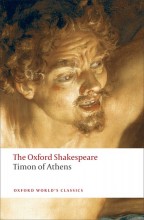
If you liked Death of a Salesman by Arthur Miller, you should read Timon of Athens by William Shakespeare. Like Miller’s Willy Loman, Timon does not enjoy an especially happy life, although from the outside it seems as though he should. Timon once had a good thing going, but creates his own misery after lavishing his considerable wealth on friends. He eventually grows to despise humanity and the play follows his slow demise.
If you liked Bury My Heart at Wounded Knee by Dee Brown, you should read The Souls of Black Folk by W. E. B. DuBois. Many argue that each of these texts should be required reading in all American schools. The Souls of Black Folk sheds light on a dark and shameful chapter of history, and of the achievements, triumphs, and continued struggles of African Americans against various obstacles in post-slavery society.
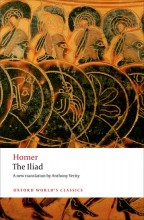 If you liked Slaughterhouse-Five by Kurt Vonnegut, you should read The Iliad by Homer. Written 2,700 years ago, The Iliad may just be the original anti-war novel, paving the way for books like Slaughterhouse-Five. Illustrating in poetic form the brutality of war and the many types of conflict that often lead to it, the periodic glimpses of peace and beauty that punctuate the story only serve to bathe the painful realities of battle in an even starker light.
If you liked Slaughterhouse-Five by Kurt Vonnegut, you should read The Iliad by Homer. Written 2,700 years ago, The Iliad may just be the original anti-war novel, paving the way for books like Slaughterhouse-Five. Illustrating in poetic form the brutality of war and the many types of conflict that often lead to it, the periodic glimpses of peace and beauty that punctuate the story only serve to bathe the painful realities of battle in an even starker light.
If you liked The Lord of the Flies by William Golding, you should read Oliver Twist by Charles Dickens. This 19th century Victorian novel explores the survival of good, utilizing England’s workhouse system and an orphaned boy as vehicles to navigate its themes. Dickens was considered the most talented among his contemporaries at employing suspense and violence as literary motifs. The result was a classic work of literature that continues to be a favorite for many.
 If you liked The Handmaid’s Tale by Margaret Atwood you should read The Scarlet Letter by Nathaniel Hawthorne. If strong female protagonists are your thing you will probably enjoy Hester Prynne, who endures public scorn after bearing a child out of wedlock, and faces a punishment of wearing a red “A” to designate her offense. Despite the severe sentence, Hester maintains her faith and personal dignity, all while continuing to support herself and her baby—not an easy feat in a 17th century puritan community.
If you liked The Handmaid’s Tale by Margaret Atwood you should read The Scarlet Letter by Nathaniel Hawthorne. If strong female protagonists are your thing you will probably enjoy Hester Prynne, who endures public scorn after bearing a child out of wedlock, and faces a punishment of wearing a red “A” to designate her offense. Despite the severe sentence, Hester maintains her faith and personal dignity, all while continuing to support herself and her baby—not an easy feat in a 17th century puritan community.
If you liked One Hundred Years of Solitude by Gabriel Garcia Marquez, you should read The Canterbury Tales by Geoffrey Chaucer. A colorful and eclectic assortment of characters make the best of a long and arduous pilgrimage by entertaining each other with tall tales of every genre from comedy to romance to adventure. If you enjoy certain aspects of Garcia Marquez’s writing, namely the fantasy elements and large cast of characters in One Hundred Years, you will probably appreciate those same characteristics in this novel, which was written 600 years ago and is still admired today.
 If you liked The Grapes of Wrath by John Steinbeck, you should read My Antonia by Willa Cather. A similar tale of survival in a harsh new land, My Antonia provides the context for a romance between two mufti-dimensional characters. Cather offers readers a glimpse into settler life in the nascent stages of American history, with vivid landscape descriptions and universal themes of companionship and family as added bonuses.
If you liked The Grapes of Wrath by John Steinbeck, you should read My Antonia by Willa Cather. A similar tale of survival in a harsh new land, My Antonia provides the context for a romance between two mufti-dimensional characters. Cather offers readers a glimpse into settler life in the nascent stages of American history, with vivid landscape descriptions and universal themes of companionship and family as added bonuses.
For over 100 years Oxford World’s Classics has made available the broadest spectrum of literature from around the globe. Each affordable volume reflects Oxford’s commitment to scholarship, providing the most accurate text plus a wealth of other valuable features, including expert introductions by leading authorities, voluminous notes to clarify the text, up-to-date bibliographies for further study, and much more. You can follow Oxford World’s Classics on Twitter, Facebook, or here on the OUPblog. Subscribe to only Oxford World’s Classics articles on the OUPblog via email or RSS. – See more at: http://blog.oup.com/2014/08/daniel-deronda-book-design/#sthash.BydtPSF1.dpuf
For over 100 years Oxford World’s Classics has made available the broadest spectrum of literature from around the globe. Each affordable volume reflects Oxford’s commitment to scholarship, providing the most accurate text plus a wealth of other valuable features, including expert introductions by leading authorities, voluminous notes to clarify the text, up-to-date bibliographies for further study, and much more. You can follow Oxford World’s Classics on Twitter, Facebook, or here on the OUPblog. Subscribe to only Oxford World’s Classics articles on the OUPblog via email or RSS. – See more at: http://blog.oup.com/2014/08/daniel-deronda-book-design/#sthash.BydtPSF1.dpuf
If you liked One Flew Over the Cuckoo’s Nest by Ken Kesey, you should read The Trial by Franz Kafka. Psychological thrillers don’t get much better than The Trial, a book that incorporates various themes including guilt, responsibility, and power. Josef K. awakens one morning to find himself under arrest for a crime that is never explained to him (or to the reader). As he stands trial, Josef gradually crumbles under the psychological pressure and begins to doubt his own morality and innocence, showing how Kafka used ambiguity brilliantly as a device to create suspense.
Featured image: Timeless books by Lin Kristensen. CC-BY-2.0 via Wikimedia Commons.
The post A back-to-school reading list of classic literature appeared first on OUPblog.

 The following post by bookseller Melissa was cross-posted with permission from her blog, Scuffed Slippers and Wormy Books. Thanks to Melissa for allowing us to share her perspective!
The following post by bookseller Melissa was cross-posted with permission from her blog, Scuffed Slippers and Wormy Books. Thanks to Melissa for allowing us to share her perspective!
Fall has (almost) arrived. Cool weather, pretty fall color, yummy drinks composed of apple cider or hot cocoa, and I get to wear scarves (I like scarves as an accessory).
And standardized testing, if you are or have a school-age child.
In my area of the country, it seems school districts have chosen testing that calculates a Lexile score for a child’s reading level with an associated score range. Lexile is a company that uses a software program to analyze books for word usage, sentence length, etc. and produce a Lexile Text Measure for each book (I copied the description from the Lexile Analyzer site):
The Lexile ® measure of text is determined using the Lexile Analyzer ®, a software program that evaluates the reading demand—or readability—of books, articles and other materials. The Lexile Analyzer ® measures the complexity of the text by breaking down the entire piece and studying its characteristics, such as sentence length and word frequency, which represent the syntactic and semantic challenges that the text presents to a reader. The outcome is the text complexity, expressed as a Lexile ® measure, along with information on the word count, mean sentence length and mean log frequency.
Generally, longer sentences and words of lower frequency lead to higher Lexile ® measures; shorter sentences and words of higher frequency lead to lower Lexile ® measures. Texts such as lists, recipes, poetry and song lyrics are not analyzed because they lack conventional punctuation.
I’m not a huge fan of putting a “score” on a book based simply on a computer generated metric because the software doesn’t take into account context or content of a book. Or form, cf poetry. But this seems to be accepted by the educational powers-that-be, so it’s here for the time being. However, I don’t know how well or often the scores are explained to parents, because I wind up in a lot of parent-bookseller conversations like this:
Parent: My child has a Lexile score of XXXX. She has to read books in the range of XXXX-XXXX. Will this work?
Bookseller [thinks]: Craaaaaaaaap.
Bookseller [says]: Well, let’s pull up the Lexile site to see what it suggests for that range and go from there.
The major problem here is that the parent hasn’t THE FOGGIEST IDEA what books go with the child’s Lexile score or how score ranges line up

The Sun Also Rises, a title with a confusing Lexile identity
with likely grade-levels. They don’t have/haven’t been provided with a list of suggestions for the range. They haven’t looked up Lexile on the Internet to get a handle on what this thing is (I mean, hello, the Internet is the Information Superhighway, Google it). And their poor child is off in the corner trying desperately to read another Warriors book by Erin Hunter or Wimpy Kid or the new Babymouse before the “grown-ups” force her into reading stuff that she thinks she doesn’t want to read.
As booksellers (and by extension librarians, a population I am not a member of but respect greatly), we are the information gatekeepers the parents turn to in this situation. We are the ones to take an abstract range of numbers and turn it into a physical pile of titles and authors. We have to differentiate between editions because scores can fluctuate wildly and Lexile isn’t very informative (type “The Sun Also Rises” into Lexile – the old Scribner edition has a score of 610L, the ISBN for the reprint isn’t found, and the Modern Critical Interpretations edition is listed with a score of 1420L….confusing, right?). And we are the ones who have to know what stories lay between the covers of those books so we can explain the contents to the parents.
In almost every customer interaction regarding Lexile, I have had to find books for a child who reads significantly above grade level (at grade level is generally pretty easy and parents with children under grade level often have a list of recommended titles as a starting point; for some reason, those children who read above grade level don’t have many recommendations). For reference, Lexile gives a grade approximation for the score ranges:
Even though the approximate ranges are pretty wide, a book or series that is popular among peers isn’t often in the “right” score range for an advanced reader. Some titles are marked “NC” meaning a non-conforming score (higher than intended audience) but it’s hard to tease those out of a range during a search (I’ve tried). It can get pretty emotional when the child cannot find anything he or she wants to read or that parents will allow them to read that “counts” for their Lexile score.
The biggest grade-to-score discrepancy I’ve come across was a seventh grade boy (and a bit young socially for his age) who had a Lexile score greater than 1100. His Lexile range was approximately 1150 – 1210. The boy had to read at least five books that semester in his range to pass English and he was already behind. His father had done some online research and was at a loss – he was having trouble finding content-appropriate books in that score range (there was also a religious consideration, so a lot of recommended fantasy titles were automatically out). The boy was very open to reading Stephen King, who has a lot of high-Lexile score titles, but the idea was vetoed by Dad due to language (and probably the religious consideration as well). Dostoevsky was perfectly acceptable to Dad, but the kiddo really couldn’t get excited about it (he was into Gary Paulsen’s Brian series, but that wasn’t even close). Some Dumas was in the right range but not the more appealing titles (The Three Musketeers and The Man in the Iron Mask are both under 1000). Gary Paulsen’s My Life in Dog Years was just in range, so I was able to interest both parent and child in that. I sold them on The Hound of the Baskervilles and then hit paydirt with The Curious Incident of the Dog in the Nighttime. The boy had a friend with an Asperger-like syndrome and they were friends in their advanced math classes. Whew. Finally, three books and a reasonably happy father. But I couldn’t help but think – what are they going to do as the child continues through the school system?
You’re probably wondering where I’m going with all this since this isn’t quite the usual tone for a “‘Tis the Season” post.
Well, I really just wanted to put this out there to maybe help save parents, children, and teachers (and possibly other booksellers and librarians) 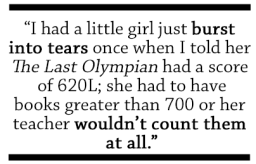 some grief. I would like to ask school administrators and teachers to work with children and parents to come up with lists of possible books appropriate to both grade-level and Lexile range (and I understand if you do this and the parents forget, are obstinate, or leave the list at home when they head to the bookstore). For parents, Lexile provides a map with lists of titles for score ranges. It’s a good place to start when trying to find books.
some grief. I would like to ask school administrators and teachers to work with children and parents to come up with lists of possible books appropriate to both grade-level and Lexile range (and I understand if you do this and the parents forget, are obstinate, or leave the list at home when they head to the bookstore). For parents, Lexile provides a map with lists of titles for score ranges. It’s a good place to start when trying to find books.
I would also like to ask teachers to be less rigid when assigning Lexile-related reading assignments because this seems to be where children have the most trouble. I have so often helped kids who love, love to read but have found that none of the books they find appealing “count” for a reading assignment because they aren’t in the “right” Lexile range or have no score because either the book is too new or has an un-evaluable format. These kids feel disheartened, that they’re failing, that the things they love are unimportant, and I hate seeing their disappointment when I’ve gone through the entire stack of books they’ve picked out and not a single one was in the right range. I had a little girl just burst into tears once when I told her The Last Olympian – the book she so desperately wanted to read – had a score of 620L; she had to have books greater than 700 or her teacher wouldn’t count them at all. Please let children with high Lexile ranges count some of those lower-scoring books toward their reading assignment (say, an exchange of two non-Lexile books for one Lexile book, not to exceed half the assignment) or perhaps give them extra credit for those books as long as they’re keeping up with the Lexile assignment (if you’re already doing that, bravo!). These kids are reading because they love reading and they’re already reading outside of school, which is sort of the point of those types of assignments. I rarely hear of a child being penalized for reading above his or her range so I think there’s a compromise that can be reached for those kids who want to read but have trouble finding books due to age or content.
So bring your Lexile ranges to me and I and my fellow booksellers and librarians will do our best to find what you like to read as well as what you need to read – if we’re very good, that book will fill both requirements. ‘Tis that sort of season.
Filed under:
Common Core State Standards,
Educator Resources Tagged:
back to school,
booksellers,
common core,
lexile 

Hi everyone,
I am doing a Back-to-School sale @ my on-line store!!
$20 purchase or more 10%off - Coupon Code: schoolrock
$35 purchase or more 20%off - Coupon Code: schoolfun
Sale end Sept 23
Hi everyone,
I am doing a Back-to-School sale @ my on-line store!!http://alinachau.com/store/$20 purchase or more 10%off - Coupon Code: schoolrock
$35 purchase or more 20%off - Coupon Code: schoolfun
Sale end Sept 23
Thank you, Mr. Falker by Patricia Polacco
Let me start by saying I am an unmitigated Polacco fan, and among the many books she has written, this may just be my favorite.
It packs a wallop if picture books can, amidst their recent much-heralded demise, continue to do such a thing. This one definitely does.
As a new school year is in the offing, most of us, if we search our memories, can recall with perfect clarity a teacher who had a life changing effect on our life, both academic and otherwise. These are often defining moments as we look back. Sometimes it was not that dramatic – perhaps a random word of encouragement, some extra time spent or an affirmation at a time when we needed it most.
I had two such remarkable people who stretched me and made me want to excel. One was my 6th grade teacher and the other taught English in my sophomore year in high school. They showed me the possibilities of what could be, not what was. They were most probably the reason I became a teacher. One of them is still in my life as a friend and mentor, meeting her again after many years. The other, I bumped into quite randomly in Sag Harbor as I was entering a restaurant several years ago. I got the chance to say “thank you” to my version of Mr. Falker and it felt great!
This is the true story of one of Ms. Polacco’s childhood school experiences, dense with the richness of the truth of so many things. It starts, as do most things, with a family, its traditions, and the importance it places on certain things and in that placement, the passing on of an inherent value to its children.
Readers will witness the ritual of the Polacco family and her grandfather, as he has done for generations, pouring honey on the cover of a small book and offering the youngest a taste of honey with the query, “What is that taste?” “Sweet” is the reply. Then the entire family joins in with one voice, “Yes, and so is knowledge, but knowledge is like the bee that made that sweet honey, you have to chase it through the pages of a book.” Trisha longs to pursue the tradition through learning to read.
Her story concretely and painfully details the power of words to hurt and to heal, the ability of a teacher to change one life at a time, simply by caring enough to probe deeper into the reason for a certain child’s struggles with academics, and the devastating effects of bullying.
For all that, it is a supremely uplifting and honest book, chronicling the difficulty faced by one child and her struggles in learning to read. The raw truth of this book as Ms. Polacco details her struggles with deciphering letters and their accompanying sounds, is juxtaposed against the caring Mr. Falker and his charismatic ability to change one child’s gradual mistaken belief that they are not smart because their learning curve is different. They have what is termed a learning disability – they process information differently.
Trisha’s drawing talent and ability become evident and are a soothing comfort in her struggle to adjust from a comforting farm life with which she is familiar, and her new life as the family moves to California. Her reading struggles intensify, accompanied by the unrelenting taunts of a classmate.
Soon, Trisha herself begins to believe the truth of the taunts – she is different, she believes and as she sees it, dumb. That difference, she mistakenly perceives is her fault and the reason for her inability to succeed and fit in. Enter Mr. Falker!
Fifth grade will be life changing. His elegant clothing and insistence on civility are only his outward hallmarks.
He gradually sees through the loneliness and fear brought on by Trisha’s inability to make sense of the squiggles on the blackboard. Promising her everything will change, he assures her that it has only been through her cunning, smartness and yes, bravery, that she has eluded and fooled many teachers in her ability to keep up.
Mr. Falker and a reading teacher meet with Trisha nearly every day and the world opens to her. It finally all begins to make sense!
She clutches a jar of honey and a book in triumph as she remembers the tradition of her family. Open sesame! The promise of the family tradition is met and kept.
Fast-forward thirty years and Trisha’s reconnection is tender as she meets again the life changing Mr. Falker or Felker, his real name. He asks her what she does for a living and thanking him, she brightly replies, “ I make books for children”.
You can’t write better than this, even in fiction.
Thanks to all the Mr. Falkers of this and every school year that have affected eternity in their ripple effect and sometimes never get to see the difference in the lives they’ve touched. This book is for you and those you’ve changed forever, whether you ever come face to face with it or not! You are the real heroes of this book, along with the students whose lives you’ve saved in the simple deciphering of the human heart.

Wow! Is summer flying by FAST  My oldest has been back to school for two weeks now yet it’s still been a struggle for us to get back into the groove of things. Anyone else having that problem? Are your kids due to go back to school soon?
My oldest has been back to school for two weeks now yet it’s still been a struggle for us to get back into the groove of things. Anyone else having that problem? Are your kids due to go back to school soon?
As always it’s time for Weekend Links. This is my chance to share some of my top picks and favorite links that I discovered in my weekly Internet travels. I am sure you will love some of these as well. Enjoy!
Feeling artsy? Check out these 10 crafts from around the world: In the Playroom

How gorgeous are these!!?? 30 Cool Art Techniques for Kids from Buggy & Buddy!
Playful Learners: 10 Play Ideas For a Rainy Day

Gotta love a good ‘ol cardboard box! 50 THINGS YOU CAN DO WITH A CARDBOARD BOX at The Kids Activities Blog

Make a Schultute (German School Cone) for the first day of school! Kid World Citizen

I don’t have a tutorial or a link for this, but I thought it was such a beautiful first day of school activity!

Here’s the motherload of craft ideas from The Artful Parent.


What great finds did you discover this week?
The post Weekend Links: Feeling Artsy and Craftsy appeared first on Jump Into A Book.
A list of beginning of the year read aloud books to set a positive climate and kick start your workshop.
Last week I wrote a post titled How To Plan A Minilesson From Scratch, and I outlined a very simple way to plan minilessons, based on the work of my wonderful colleagues at the Teachers College Reading and Writing Project. Now, I am going to backtrack a bit and revisit just a teensy weensy bit of what I said. I wrote, "Every minilesson can pretty much go the same way." And this is absolutely true, most of the time. Except for those times when it's not true.
 My Teacher Is a Monster!
(No, I Am Not.)
My Teacher Is a Monster!
(No, I Am Not.)
by Peter Brown; illus. by the author
Primary Little, Brown 40 pp.
7/14 978-0-316-07029-4 $18.00
From the cover, it is clear that Bobby and his teacher do not agree: “My Teacher Is a MONSTER!” says Bobby in a giant word balloon; Ms. Kirby replies, “No, I Am Not.” It’s true that she is much taller than tiny Bobby, her skin is monstrously green, and she has claws and sharp teeth and giant nostrils. They clash in class when Bobby sends a paper airplane flying, but when later they meet unexpectedly at the park, they begin to see each other differently. In a multi-page sequence of panels, the pair sits awkwardly together on a park bench, and they converse in word bubbles: “Ms. Kirby, it’s REALLY strange seeing you outside of school.” “I agree.” After Bobby catches her blown-off hat for her, they find more things to do together, and gradually in each picture, Ms. Kirby looks decreasingly monstrous as her face becomes less green and animal-like. Bobby isn’t perfect at the end, and Ms. Kirby reverts to a little of her scariness when Bobby disobeys, but child readers will understand the subtle shift in their relationship. Using thick paper and watercolor/gouache/India ink illustrations, Brown uses a cartoon-type format with panels and speech bubbles, varying the pace with full-page art, in a story that students and teachers will enjoy equally.
From the July/August 2014 issue of The Horn Book Magazine.

The post Review of My Teacher Is a Monster!
(No, I Am Not.) appeared first on The Horn Book.

It’s time to go back to school!It’s finally time to go back to school! YAYYYY!!! There are so many reasons to get excited about going back to school but for today’s Who Would Win, please choose between these 2:
Which is better?
Having the best school library OR having the best school supplies in your school bag?

Leave your vote in the Comments. And tell us your favorite part about going back to school
.
–Sonja, STACKS Staffer
The librarian photo credit aussiegal; My schoool bag photo credit anasararojas
Follow the Line to School by Laura Ljungkvist
In the tradition of series books like “I Spy” and “Where’s Waldo” comes Laura Ljkungkvist’s books, “Follow the Line”.
Born in Sweden, she honed her talents as a freelance illustrator. “The New Yorker”, “Harper’s Bazaar and “House and Garden” were in the mix of her varied clients.
She then segued to author and illustrator of seven children’s books, including four “Follow the Line” series. Creativity and rule following don’t necessarily go hand in hand, so I had to laugh out loud when I read her dedication:
“To all the teachers who, over the years
tried to make me put down my pencil, stop drawing
and pay attention in class.”
Thank heavens this was not the case, as delving into Ms. Ljunkgvist’s book, “Follow the Line to School” produces a linear, exciting chalk line which, for a child returning or even beginning school, is reassuring, informational and gets them to “put their thinking cap on” using a creative and interesting formula. Following the line is easy, fun and fact-filled.
From the outset, school is described as “exciting” with its introduction to music, reading, math and writing. The typical school day is mapped out with time for lunch, recess and art.
Knowing what something looks like and what will greet you when you get there can definitely be the shot in the arm of confidence a young child facing the big unknown of “SCHOOL” needs. Additionally, it may also have a calming effect on first time parents seeing their children off to school on the big day.
A charming front of a classroom is presented on one page with the class pet, Fred clearly visible at ear level. What kind of animal can he be, the child is asked? Hint: Fred has something in common with an animal referred to as a hare.
Similarly, an alphabet chart is prominent, as it is in most elementary classrooms, and one is asked what letter YOUR name starts with?
Counting elephants amid animals depicted in the science room is fun. I even noticed a penguin proudly displayed on the shelf. I admit it: I missed an elephant in the tusk count. You child will probably breeze through this one – please don’t give me up – math was my last favorite subject!
Children’s perception skills are intertwined with a collection of queries regarding a library scene, art room, mazes and games, cafeteria food, a playground, music room and finally, before departure for home, the favorite, “Show and Tell”
Her book is inventive, fresh, comfortable and learning oriented with an ability to hold a child’s interest and imagination.
Ms. Ljunkgvist has learned her lessons well as a children’s book author, meaning she hasn’t forgotten what it feels like to BE a child or what appeals to them.
It’s a great read for the child starting, returning or apprehensive about the school experience. Its final pages announce, “It’s so much fun to learn new things tomorrow brings”, with the ever present chalk line leading off into the future in much the same way as the day began. “Follow the Line to School” gives a positive spin of possibilities to a child’s school experiences. Kids will take to it and fall in love with the class pet, Fred. He’s cute. Hint: He has wiggly ears!
Come visit the shop this weekend for more free goodies, new prints and cards, and amazing deals on bookmarks, washi tape, stickers, and stamps. Also, make sure to present your student or teacher ID for 15% off your entire purchase.
Pop-Ups by SJ Made
at Westfield Valley Fair
2855 Stevens Creek Blvd.
Santa Clara, CA 95050
M-F 10am-9:30pm
Sat 10am-9pm
Sun 11am-7pm
To find the shop, following your nose! I'm located in front of Mrs. Field's Cookies, just a skip away from the Women's Macy's.

By: Julia Hornaday,
on 8/12/2014
Blog:
First Book
(
Login to Add to MyJacketFlap)
JacketFlap tags:
books,
games,
Books & Reading,
read,
teachers,
Back to School,
school supplies,
First Book Marketplace,
learn,
calculators,
First Day First Book,
interactive learning tools,
Add a tag
Yesterday marked the first day of school for many kids across the country. And from Sacramento to Savannah, classroom shelves were stocked and backpacks stuffed to the brim with brand new books from First Book.
For over 20 years, we’ve been in the fortunate position to help teachers get the books their students need to start school off strong. And this year is no different. In fact, we’re now offering more tools than ever before to help kids in need read, learn and succeed. In addition to books, our network of 130,000 educators and program leaders will also be able to access games, bookmarks, school supplies and interactive learning tools for the kids they serve.
Check out some of the cool new tools we’re offering on the First Book Marketplace – just in time for back to school:
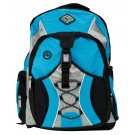 Backpacks
Backpacks
How else will kids carry all their great new books?
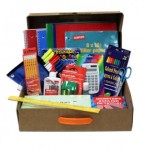 Kits for Kidz
Kits for Kidz
Notebooks, pencils, scissors, a ruler – these ready-made kits contain 30 essential items required for an entire school year. Available for primary, elementary and junior high school.
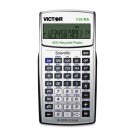 Calculators
Calculators
Help kids stay on track during math class with brand new calculators. Scientific and pocket calculators available in carton or single quantities.
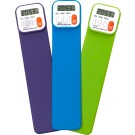 Mark-My-Time Digital Bookmarks
Mark-My-Time Digital Bookmarks
Vibrant digital bookmarks enable kids (and their caregivers) to track their reading time and feel a sense of accomplishment.
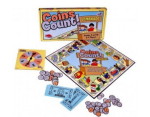 Coins Count!
Coins Count!
Coins Count! is a fun board game that helps kids make sense of money and learn the value of pennies, nickels, dimes, quarters, and dollar bills.
Bug Barn Kit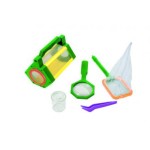
This fun viewing barn and tools helps lets do hands-on science explorations and take a closer look at the natural world.
Do you work with kids in need? Sign up with First Book today to access all these great learning resources.
The post More Than Books for Back to School appeared first on First Book Blog.

<!--[if gte mso 9]>
Normal
0
false
false
false
EN-US
X-NONE
X-NONE
MicrosoftInternetExplorer4
<![endif]--> 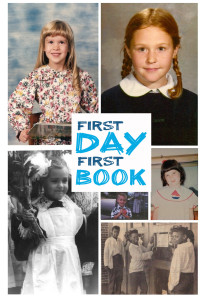 The first day of school is a memorable time for kids, teachers, and parents alike!
The first day of school is a memorable time for kids, teachers, and parents alike!
We’ve started posting our back to school memories on Instagram, and we want to see yours, too!
Share your pictures of a first day at school through your social media channels. They can be pictures of your class, your children, or a “vintage” photo of yourself!
We’ll re-post your picture on our Instagram account, and every Monday we’ll feature one of our favorite pictures with all our fans on our Facebook page.
If you’re sharing on Instagram, tag FirstBookOrg and hashtag your photo with #firstdayfirstbook.
If you’re sharing on Twitter, upload the picture to your status update and make sure @firstbook and #firstdayfirstbook are in your tweet!
If you’re sharing on Facebook, simply upload the picture to our wall.
Send along your favorite photo any time before September 22.
We can’t wait to see your first day photos!
The post Share Your First Day with First Book! appeared first on First Book Blog.

Kids going back to school — or just starting out there? Here are a variety of picture books, from imaginative and funny to historical and serious, to help ease the transition from the lazy days of summer.
 “Roar! Roar! Roar!” The diminutive red dinosaur from Bob Shea’s Dinosaur vs. Bedtime faces its newest foe in Dinosaur vs. School. The new kindergartner romps and stomps its way through the day, making new friends, playing dress-up, and creating “monkey snacks.” In each case, “Dinosaur wins!” The fun comes to a halt at clean-up time: “OH, NO! It’s too much for one dinosaur!” But there’s a valuable little-kid lesson to be learned: “When everyone helps… EVERYONE WINS!” The mixed-media illustrations contain lots of color and motion, with real-life objects incorporated humorously into the digital collage. (Disney-Hyperion, 3–5 years)
“Roar! Roar! Roar!” The diminutive red dinosaur from Bob Shea’s Dinosaur vs. Bedtime faces its newest foe in Dinosaur vs. School. The new kindergartner romps and stomps its way through the day, making new friends, playing dress-up, and creating “monkey snacks.” In each case, “Dinosaur wins!” The fun comes to a halt at clean-up time: “OH, NO! It’s too much for one dinosaur!” But there’s a valuable little-kid lesson to be learned: “When everyone helps… EVERYONE WINS!” The mixed-media illustrations contain lots of color and motion, with real-life objects incorporated humorously into the digital collage. (Disney-Hyperion, 3–5 years)
 From the author-illustrator of Mr. Tiger Goes Wild comes another funny and perceptive picture book, My Teacher Is a Monster! (No, I Am Not.). To young Bobby, his rule-enforcing teacher Ms. Kirby looks like a monster, with green skin and sharp claws and teeth. But when the two meet unexpectedly outside of school one day, he begins to see her as more human, and gradually Ms. Kirby begins to look decreasingly monstrous. In watercolor, gouache, and India ink illustrations on thick paper, Peter Brown employs a cartoon-type format (with panels and speech bubbles) to tell a story that students and teachers will enjoy equally. (Little, Brown, 3–5 years)
From the author-illustrator of Mr. Tiger Goes Wild comes another funny and perceptive picture book, My Teacher Is a Monster! (No, I Am Not.). To young Bobby, his rule-enforcing teacher Ms. Kirby looks like a monster, with green skin and sharp claws and teeth. But when the two meet unexpectedly outside of school one day, he begins to see her as more human, and gradually Ms. Kirby begins to look decreasingly monstrous. In watercolor, gouache, and India ink illustrations on thick paper, Peter Brown employs a cartoon-type format (with panels and speech bubbles) to tell a story that students and teachers will enjoy equally. (Little, Brown, 3–5 years)
 Since we last saw her in Miss Brooks Loves Books! (and I don’t), narrator Missy has developed a newfound appreciation for books. Now, in Barbara Bottner’s Miss Brooks’ Story Nook (where tales are told and ogres are welcome), she eagerly anticipates being read to each morning, though a neighborhood bully makes it hard to get to school on time. Then the power goes off, and the class must tell stories rather than read them. Missy makes up a story about an ogre, which helps her solve her bully problem. Michael Emberley’s pleasingly detailed pencil-and-wash illustrations give the characters distinctive personalities. (Knopf, 4–7 years)
Since we last saw her in Miss Brooks Loves Books! (and I don’t), narrator Missy has developed a newfound appreciation for books. Now, in Barbara Bottner’s Miss Brooks’ Story Nook (where tales are told and ogres are welcome), she eagerly anticipates being read to each morning, though a neighborhood bully makes it hard to get to school on time. Then the power goes off, and the class must tell stories rather than read them. Missy makes up a story about an ogre, which helps her solve her bully problem. Michael Emberley’s pleasingly detailed pencil-and-wash illustrations give the characters distinctive personalities. (Knopf, 4–7 years)
 Separate Is Never Equal: Sylvia Mendez & Her Family’s Fight for Desegregation by Duncan Tonatiuh uses a child’s viewpoint to tell the remarkable story of how, seven years before the landmark Supreme Court case Brown v. Board of Education, a Mexican American child and her family fought for — and won — the desegregation of schools in California. Illustrations reminiscent of the Mixtec codex, but collaged with paper, wood, cloth, and brick, accompany the straightforward narrative. This story deserves to be more widely known, and now, thanks to this book, it will be. (Abrams, 6–9 years)
Separate Is Never Equal: Sylvia Mendez & Her Family’s Fight for Desegregation by Duncan Tonatiuh uses a child’s viewpoint to tell the remarkable story of how, seven years before the landmark Supreme Court case Brown v. Board of Education, a Mexican American child and her family fought for — and won — the desegregation of schools in California. Illustrations reminiscent of the Mixtec codex, but collaged with paper, wood, cloth, and brick, accompany the straightforward narrative. This story deserves to be more widely known, and now, thanks to this book, it will be. (Abrams, 6–9 years)
From the August 2014 issue of Notes from the Horn Book.

The post Back-to-school basics appeared first on The Horn Book.
Fostering a nurturing writing community at the beginning of the school year means taking the time to build a community of writers. Here's an artistic way you can have students introduce themselves, and their quirks, to their peers.
ICYMI: A look back at our blog series about sharpening workshop routines.
 For many, back to school time is a time for learning new things. One thing I’m trying to learn more about and be better at is listening to what people in the community need and want from the library instead of simply going out and telling people what the library has to offer. For example, at a back to school professional development event library staff might be asked to present information on what they have to offer to teachers and students. Typically that might mean going in and saying, “Hi, we have these databases, they are great, use them.” Then we leave and hope that that helped inform teachers about how they can use the library’s resources.
For many, back to school time is a time for learning new things. One thing I’m trying to learn more about and be better at is listening to what people in the community need and want from the library instead of simply going out and telling people what the library has to offer. For example, at a back to school professional development event library staff might be asked to present information on what they have to offer to teachers and students. Typically that might mean going in and saying, “Hi, we have these databases, they are great, use them.” Then we leave and hope that that helped inform teachers about how they can use the library’s resources.
But, really what we should be doing is first asking teachers and staff in schools what they are doing, what do they wish was available in the community, what do they and their students need? We who work with teens in libraries listen to what they tell us and then craft a response that is focused exactly on what we heard when we listened. It’s not focusing on, this is what I think you need, it’s focused on this is what you told me you need and I can directly help that need in this way.
This isn’t just something we need to be doing with teachers at back to school time. It’s also important to talk to community partners and listen to what they are telling you they are doing for and with teens. From that listening you can then find ways to connect what you have to offer – expertise, materials, connections to others in the community. Whatever it is, if you listen you’ll better be able to connect to an actual need, instead of a perceived one.
And, of course, this also relates to the work we do directly with teens. We need to truly listen to what they have to say about their lives and what they need. Instead of telling them what we can do for them or thinking that they need a particular program or service, it’s up to use to ask and listen.
I think one of the hard parts of this is that listening requires not just asking the questions but also analyzing what we hear without simply using preconceived ideas and notions in that analysis. To truly listen it’s important to take what people tell you – adults or teens, parents or teachers, friends or colleagues – and think that you might (and probably are) hear something totally unexpected. Then you need to take what you hear and use it to create something new and innovative or to retweak something that you’ve been doing a particular way for a short or long period of time.
This fall as teens are going back to school and being asked to listen in their classrooms, do the same thing yourself. Listen to what people in your community are telling you about what they need from the library. Then work to give them what they actually need, and not what you wish or hope or think they need. It will improve your service and help to make the library an integral part of the community that teens, and others, can’t live without.
To learn more about what’s going on in education and learning and responding to community needs try these Twitter hashtags:
#act4teens is a YALSA created hashtag that focuses on how to advocate and support teens in the community.
#commoncore is a great hashtag for hearing what people are saying about the common core and how it is being integrated into teaching and learning.
Also, don’t forget to follow hashtags for your local newspapers, schools, etc. as they are sure to give you lots of information about what’s going on and give you ideas for what you want to ask in order to hear what people need.


By: Elizabeth Moore (@BethMooreTCRWP),
on 8/7/2014
Blog:
TWO WRITING TEACHERS
(
Login to Add to MyJacketFlap)
JacketFlap tags:
organization,
classroom,
management,
writing workshop,
back to school,
furniture,
work space,
procedures,
writing center,
Sharpen Your Routines Blog Series,
writing workshop routines,
Add a tag
Every year, around this time, I start having dreams about setting up my classroom. In the classroom of my dreams, I’m moving around small circular tables, unfurling a brand new rug for the… Continue reading →
Are you looking to make the most out of your classroom's meeting area? Find out how to create and maintain a meeting area that will function as the focal point of your writing workshop. 
Welcome to August and the first in a series of YALSAblog posts all about getting ready for the new school year.
 I don’t think there is a better way to get started thinking about going back to school then to check-in with YALSAblog readers about how you are implementing the ideas in the Future of Library Service for and with Teens: A Call to Action report published by YALSA in January of this year.
I don’t think there is a better way to get started thinking about going back to school then to check-in with YALSAblog readers about how you are implementing the ideas in the Future of Library Service for and with Teens: A Call to Action report published by YALSA in January of this year.
Thinking about the fall and the programs and services we’ll work on with and for teens during the school year is a great time to learn about what others are doing that connect to the ideas in YALSA’s report. At the YALSAblog we’d love to hear what you have made happen that connect to what’s outlined in the report. For example:
- Have you added or expanded or started connected learning opportunities for teens in your library? If you have questions about what connected learning is all about and what you might do with teens in that area check out the YALSAblog’s previous posts on that topic or pages 8-10 in the report.
- In what ways are you giving teens opportunities to connect with mentors and coaches in order to help them learn about the topics in which they are most interested? See pages 21-23 in the report for more on this topic.
- Are you finding new or expanded ways to integrate services that help teens to gain a variety of literacy skills from print literacy to media literacy to digital literacy? See pages 6-8 in the report for more on this topic.
- Have you found a new way to think about the way you staff your teen services in order to better support the current and future needs of teens? See page 24 in the report for more on this topic.
- Are there new ways you are thinking about the way that you provide space to teens? See pages 23-24 in the report for more on this topic.
- Have you expanded or re-thought your ideas about collaborations and partnerships in order to move into the future of service for and with teens? See pages 13-14 and 23 in the report for more on this topic.
I bet lots of YALSAblog readers are doing great things that demonstrate the ideas in the YALSA “futures report.” And, I bet that there are library staff working with teens that wonder, “how do I get started implementing the ideas in the report?” There is no better time to start talking about the successes and challenges of bringing the future of library service to teens in your libraries than as you plan for the 2014/15 school year in your library. Let’s hear what you’ve been able to try out as a result of reading the report and/or what you are struggling with in terms of the report in the comments.
The discussion of the future starts now!
And, by the way, there are some great ways for you to keep up with what’s going on in the world of libraries and education as it relates to the future of services for and with teens. Try these Twitter hashtags to get started:
- #act4teens – the tag started by YALSA for all ideas related to how libraries and others are supporting the needs of teens.
- #connectedlearning – all about what connected learning is and how we can improve the lives of youth through connected learning experiences.

Froggy Goes to School
By Jonathan London; illustrated by Frank Remkiewicz
For those of the Baby Boomer generation, there was a jingle on the radio that signaled the end of all things summer. It presaged school, schedules, earlier bedtimes and butterflies in the tummy time, as all manner of imaginings emerged before the first day of school. The jingle was sponsored by a clothing store long since defunct, having gone the way of chain stores such as E.J. Korvettes and Alexanders. It’s still on YouTube. The popular, but ominous jingle went:
School bells ring and children sing,
IT’S BACK TO ROBERT HALL AGAIN!
Mother knows for better clothes,
IT’S BACK TO ROBERT HALL AGAIN!
You’ll save more on clothes for school,
SHOP AT ROBERT HALL!
To quote the anvil salesman from “The Music Man”, “Not on your life, girly, girl!” We did not shop at Robert Hall because as do many public and private school students of today, we wore a UNIFORM – that great leveler of individuality and competition in school attire. Come to think of it, does the antsy amphibian, Froggy, wear a uniform to school?
Find out from that famous frog, as he is a GREAT go to read aloud for parents and kids facing their very first day of school or their 3rd!
Can you parents remember sometimes having had dreams preceding the first day of school about being late via missed buses because of alarm clocks that don’t ring? Froggy’s nightmare is a bit more extreme. Though awakening late, he does make the bus, BUT forgets to don school clothes of ANY KIND save undies!! Thank goodness, he wakes up to his father’s bright “Rise and shine,” (my dear mom used the SAME line), to discover his worst fears were a DREAM.
Young readers can fully identify with the green goggle-eyed young frog that is an easy stand in for them and their concerns. Froggy shares them and lives them – first.
Kids will feel a calm settling over their pre-school nervousness as Froggy joins in the school days activities with relish, getting some things right, like his name printed on the desk, while other skills need a bit more work such as paying attention, speaking softly and not falling out of his seat!
Young back-to-schoolers who find themselves drawing comparisons to Froggy, will find similarities and a few relieved, “Hey, I never did that!”
The youngsters are having a fine time with their teacher, Miss Witherspoon, sharing their summer adventures, when Mr. Mugwort, the Croc enters with a glare on his face just as Froggy is singing the song he learned when he was taught to swim. Is Froggy in trouble on his very FIRST day? No way! Mr. Mugwort is a singer of songs too!
Please join Froggy and your young reader in allaying all fears about the first day of school. If Froggy and family can happily navigate the return to school, so can you and your young scholars!

In honor of back to school, we have been posting some rather stunning statistics about how many teachers spend money out of their own pockets for their classroom, as well as how much they are spending. Teachers across the web have responded.
- “Yup on average about $500” (twitter)
- “$480? Really? WAY more than that. I think I have spent that this month alone.” (facebook)
- “The government gives us a $250 tax break. The rest is all us” (twitter)
- “That $480 figure people throw around makes me LOL. I spend at least $1000 a year on books, paper, etc.” (twitter)
- “Oh please don’t post how much we spend! My husband doesn’t need to know this!” (facebook)
- “Sometimes it’s even more for many teachers…” (facebook)
These responses have come from teachers registered with First Book as well as those who are not. For those who are, First Book helps cover the cost of books to help teachers get more and pay less.
But we can’t do this without you. Every $10 you provide puts 4 books into the hands of a teacher for her classroom. Donate now for back to school!
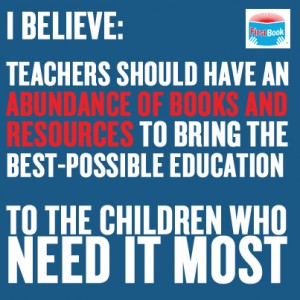
The post Teachers Spend $480 Or More on Back To School Supplies for Their Classrooms appeared first on First Book Blog.

We can all learn something from the selfless acts of children. Check out these five stories of kids helping kids in need get new books.
1. The Best Neighbor Ever.
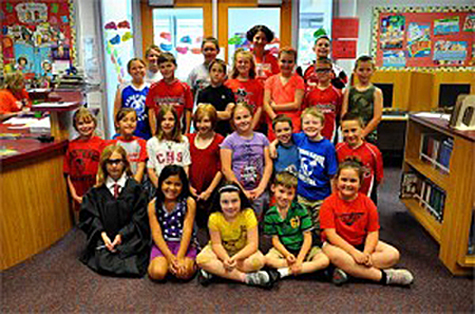
Crestwood Intermediate School in Mantua, Ohio puts others first. The 3rd-5th graders raised over $1300 through a First Book Virtual Book Drive. They set out to raise this money not for themselves, but for a neighboring school in their community, David Hill Learning Center. Crestwood was determined to make sure that their friends at David Hill would have books to call their own.
2. The 10-Year-Old Entrepreneur.
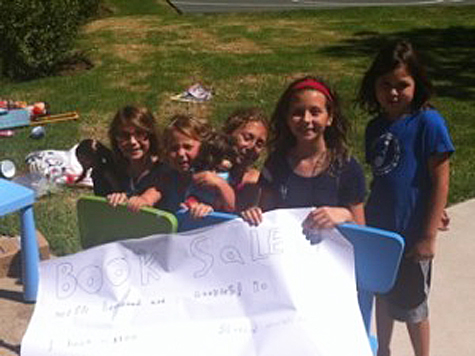
Malaika became a young social entrepreneur at the ripe age of 10-years-old. She wanted kids less fortunate than her to be able to enjoy books so she raised money through a book and lemonade stand and donated it all to First Book. She provided over 30 books to kids in need.
3. The Coin Collectors
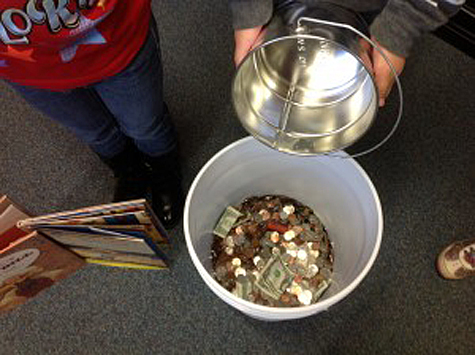
Students at Union Elementary in Farmington, CT turned pockets full of change into a bucket full of change. That bucket ended up providing 160 brand-new books to children affected by Hurricane Sandy.
4. All You Need Is Change.
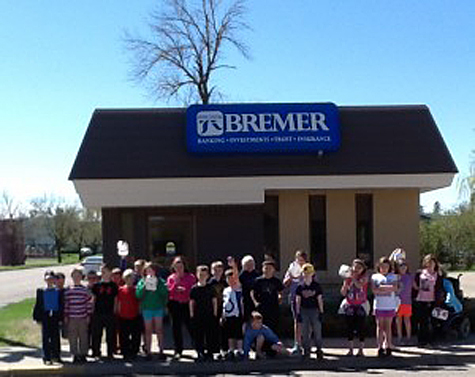
Speaking of kids making change, third graders at Fisher Elementary in MN, collected loose change for six weeks. They took a walk to the local bank and turned all that change into a donation to First Book.
5. The Birthday Girl
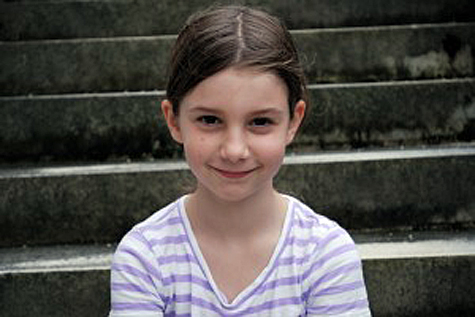
Eight-year-old Siena didn’t want toys or presents for her eighth birthday. Instead, she wanted children in need to get new books. She surpassed her goal and got her birthday wish, placing over 150 brand-new books into the hands of kids in need.
Okay, So Now What?
Join these amazing stories by helping kids in need have a steady stream of books throughout the school year.
The post 5 Inspiring Stories Of Kids Helping Kids appeared first on First Book Blog.

View Next 25 Posts




 If you liked Slaughterhouse-Five by Kurt Vonnegut, you should read
If you liked Slaughterhouse-Five by Kurt Vonnegut, you should read  If you liked The Handmaid’s Tale by Margaret Atwood you should read
If you liked The Handmaid’s Tale by Margaret Atwood you should read  If you liked The Grapes of Wrath by John Steinbeck, you should read
If you liked The Grapes of Wrath by John Steinbeck, you should read











 My Teacher Is a Monster!
(No, I Am Not.)
My Teacher Is a Monster!
(No, I Am Not.)


 Backpacks
Backpacks





 “Roar! Roar! Roar!” The diminutive red dinosaur from Bob Shea’s Dinosaur vs. Bedtime faces its newest foe in Dinosaur vs. School. The new kindergartner romps and stomps its way through the day, making new friends, playing dress-up, and creating “monkey snacks.” In each case, “Dinosaur wins!” The fun comes to a halt at clean-up time: “OH, NO! It’s too much for one dinosaur!” But there’s a valuable little-kid lesson to be learned: “When everyone helps… EVERYONE WINS!” The mixed-media illustrations contain lots of color and motion, with real-life objects incorporated humorously into the digital collage. (Disney-Hyperion, 3–5 years)
“Roar! Roar! Roar!” The diminutive red dinosaur from Bob Shea’s Dinosaur vs. Bedtime faces its newest foe in Dinosaur vs. School. The new kindergartner romps and stomps its way through the day, making new friends, playing dress-up, and creating “monkey snacks.” In each case, “Dinosaur wins!” The fun comes to a halt at clean-up time: “OH, NO! It’s too much for one dinosaur!” But there’s a valuable little-kid lesson to be learned: “When everyone helps… EVERYONE WINS!” The mixed-media illustrations contain lots of color and motion, with real-life objects incorporated humorously into the digital collage. (Disney-Hyperion, 3–5 years) Since we last saw her in Miss Brooks Loves Books! (and I don’t), narrator Missy has developed a newfound appreciation for books. Now, in Barbara Bottner’s Miss Brooks’ Story Nook (where tales are told and ogres are welcome), she eagerly anticipates being read to each morning, though a neighborhood bully makes it hard to get to school on time. Then the power goes off, and the class must tell stories rather than read them. Missy makes up a story about an ogre, which helps her solve her bully problem. Michael Emberley’s pleasingly detailed pencil-and-wash illustrations give the characters distinctive personalities. (Knopf, 4–7 years)
Since we last saw her in Miss Brooks Loves Books! (and I don’t), narrator Missy has developed a newfound appreciation for books. Now, in Barbara Bottner’s Miss Brooks’ Story Nook (where tales are told and ogres are welcome), she eagerly anticipates being read to each morning, though a neighborhood bully makes it hard to get to school on time. Then the power goes off, and the class must tell stories rather than read them. Missy makes up a story about an ogre, which helps her solve her bully problem. Michael Emberley’s pleasingly detailed pencil-and-wash illustrations give the characters distinctive personalities. (Knopf, 4–7 years) Separate Is Never Equal: Sylvia Mendez & Her Family’s Fight for Desegregation by Duncan Tonatiuh uses a child’s viewpoint to tell the remarkable story of how, seven years before the landmark Supreme Court case Brown v. Board of Education, a Mexican American child and her family fought for — and won — the desegregation of schools in California. Illustrations reminiscent of the Mixtec codex, but collaged with paper, wood, cloth, and brick, accompany the straightforward narrative. This story deserves to be more widely known, and now, thanks to this book, it will be. (Abrams, 6–9 years)
Separate Is Never Equal: Sylvia Mendez & Her Family’s Fight for Desegregation by Duncan Tonatiuh uses a child’s viewpoint to tell the remarkable story of how, seven years before the landmark Supreme Court case Brown v. Board of Education, a Mexican American child and her family fought for — and won — the desegregation of schools in California. Illustrations reminiscent of the Mixtec codex, but collaged with paper, wood, cloth, and brick, accompany the straightforward narrative. This story deserves to be more widely known, and now, thanks to this book, it will be. (Abrams, 6–9 years) For many, back to school time is a time for learning new things. One thing I’m trying to learn more about and be better at is listening to what people in the community need and want from the library instead of simply going out and telling people what the library has to offer. For example, at a back to school professional development event library staff might be asked to present information on what they have to offer to teachers and students. Typically that might mean going in and saying, “Hi, we have these databases, they are great, use them.” Then we leave and hope that that helped inform teachers about how they can use the library’s resources.
For many, back to school time is a time for learning new things. One thing I’m trying to learn more about and be better at is listening to what people in the community need and want from the library instead of simply going out and telling people what the library has to offer. For example, at a back to school professional development event library staff might be asked to present information on what they have to offer to teachers and students. Typically that might mean going in and saying, “Hi, we have these databases, they are great, use them.” Then we leave and hope that that helped inform teachers about how they can use the library’s resources. I don’t think there is a better way to get started thinking about going back to school then to check-in with YALSAblog readers about how you are implementing the ideas in the
I don’t think there is a better way to get started thinking about going back to school then to check-in with YALSAblog readers about how you are implementing the ideas in the 










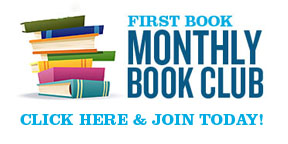
I wholeheartedly agree. Reading should not be a chore to score. I put my thoughts on the leveling of books in a photo which ran on the ALSC blog yesterday. [http://www.alsc.ala.org/blog/2014/08/thoughts-on-the-ccss/]
Hannah, when the Dept of Education in California decided to go all Lexile, around 2000, a vendor (yup!) from Lexile came to “educate” the group of 30 or so librarians, teachers, curriculum coordinators, etc. the Department had assembled to update its Recommended Reading List. I bear the scars of incredulity still. And as a librarian, I have never started a readers advisory session from the Lexile end of things and push back when parents want to go there (after all, for me, the advising is for the kid, not the parent). On the other hand, the Lexile folk seem to have more awareness of reading as an activity of the imagination than do the AR plumpers.